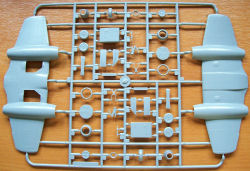
Xtrakit 1/72 Meteor F.8 Kit First Look
By Mike Abbott
| Date of Review | August 2009 | Manufacturer | Xtrakit |
|---|---|---|---|
| Subject | Meteor F.8 | Scale | 1/72 |
| Kit Number | 72001 | Primary Media | All styrene despite box information to the contrary |
| Pros | Beautiful molding, relatively simple build | Cons | |
| Skill Level | Experienced | MSRP (BP) | £11.73 |
First Look
 |
 |
 |
 |
On 15th May 1941 Great Britain entered the jet age with the first flight from RAF Cranwell of the Gloster E28/39, also known as the Pioneer. This was a lightweight experimental aircraft which did not have the capacity to become a jet fighter, in those days that needed the power of two engines. Gloster submitted their original proposal for a twin-engined fighter in 1940 resulting in Air Ministry specification F9/40 being written around it. That design became the Meteor, affectionately known as the Meatbox.
The first combat success for an F1 Meteor came on 04 August 1944 with the downing of a V1 flying bomb, not by shooting it down as the Meteors guns had jammed but by tipping it over. The Meteor did go to war over Europe, but never encountered any German aircraft, especially jets, much to the disappointment of the pilots
Development continued and the change from Welland to Derwent engines gave a much needed power boost. The definitive day fighter variant was the F8 which never fired its guns in anger with the RAF but in Korea with the RAAF who found it to be better at ground attack than being a fighter however it still succeeded in at least one MiG victory. The F8 was the most produced variant continuing as the RAF's front line fighter until the mid 50's when gradually replaced by Gloster's follow up, the Javelin and the beautiful Hawker Hunter. The sudden disbanding of the Royal Auxiliary Air Force (RAuxAF) in 1957 left a lot of Meteors on scrap dumps, however, many others continued in RAF then some went into civilian service and some are still flying today, a testament to the types longevity. We Brits are good at that, just think of the Nimrod (Comet) and Canberra (jingoism over because Americans have the C-135, B-52 and even the Russians have the Tupolev Bear)
The kit of the F8 was originally released by MPM and they now mould it for Hannants to be sold under the Xtrakits range. The kit comes in an end opening box with a full colour illustration of the camouflaged 501 Sqn RAuxAF F8 option. Information on the side is in 3 languages, English, German and Czech. The only error I can find on the box is to state there are resin parts included; there are none that I can find.
The kit has two sprues of 78 parts moulded in medium gray plastic, one clear sprue with two canopy choices and a decal sheet with three marking options. It all comes in a plastic bag with the decals inside a further bag. The instructions are in an A5 folded format in black and white showing the construction sequence pictorially with a painting guide as you go along. Colour references are for Hannants Xtracolour or Xtracrylics with colour names so you could use other ranges.
First impressions are of a well engineered kit, easy to build with good detail, the engraved panel lines are restrained, I do like the way the engines nacelles are constructed, separate intake front (two options here) and exhaust so no join lines to worry about hiding. There is a choice of canopy, the full later bubble or the filled rear early bubble but I think they have missed a trick here as the windscreen is the same for both types and separate rear canopies would have been an option. One of the canopies has some moulding blemishes in the shape of some blobs on the inside, the undercarriage also has sink marks on most of the larger components, neither should be difficult to overcome. .
There are two different intakes, normal or extended. Don't be put off by the front face of the engine, it is not like modern engines with fan blades, the Derwent 8 had a central compressor with outer combustion chambers, the front has plumbing and with subtle painting it will look good. The thick spar in front of the engine is correct as it is a continuation of the wingspar. The cockpit instrument panel looks right for an F8 and sidewall detail is adequate, with subtle drybrushing and the fact the RAF at the time generally had black cockpits, with the closed canopy it should prove o.k. Optional belly and wing tanks are provided with the latter locating into flashed over holes in the wing. The only thing the modeller has to add is the whip aerial to the top of the fuselage.
The three options available are for 222Sqn RAF & 600Sqn RAuxAF in High Speed Silver and the camouflaged 501Sqn RAuxAF. The decal sheet is well printed with roundels in register and a goodly number of stencils. The only print problem on my sheet was a blemish on the 501 Sqn markings but that could be a one off. As with a lot of modellers, I shall choose different markings, but more of that in the future.
All in all it looks a good kit and I look forward to building it. A word of warnng, if you are going to use alternative markings as I will be doing make sure you use the correct canopy and intakes for the markings you will be using. There are a few parts on the clear sprue not used which have been used for the recently released MPM RAAF version and maybe there is a FR9 in the offing.







